The 4 C's
Before the Gemological Institute of America (GIA) established the ‘4 C’s’, there was no official grading system in place. GIA developed a grading system that could uses to accurately describe and grade Diamond quality without inconsistency or misinterpretation.
Carat
Most people consider Carat to be a size, but Carat is actually a weight of measurement. A 1.00 carat Diamond is equal to 1/5 of a gram. If all other factors are equal, the Diamond prices increase with the Carat Weight.

Clarity
Clarity of a Diamond refers to the amount of, or lack of imperfections in the Diamond crystal. Clarity Grades are based on the size, nature, color, number and relief of inclusions or imperfections in the stone or on the surface that can be seen under 10x magnification.

Color
The Color Grade of a Diamond refers to how closely the approach colorlessness. The grading scale for Color is alphabetic from D-Z. D color grade represents colorless (no signs of color) down to a Z color grade where the Diamond will appear more brown or yellow in hue.

Cut
Cut first refers to shape, or the outline of the stone. Popular cuts or shapes for Diamonds include Round Brilliant, Asscher, Radiant, Cushion, Princess, Pear, Oval, Heart, Marquise, Emerald etc.

The second part of cut refers to the Cut Grade attached to Round Brilliant cut stones. Cut refers to the proportions and angles of a Round Brilliant Diamond and their relation to the brilliance and sparkle. Cut Grades are assessed by Brightness, Fire, Scintillation, Weight Ratio, Girdle Thickness, Symmetry and Polish. Cut Grade is assigned From Excellent to Poor.


Sources: GIA.EDU
1714-1837
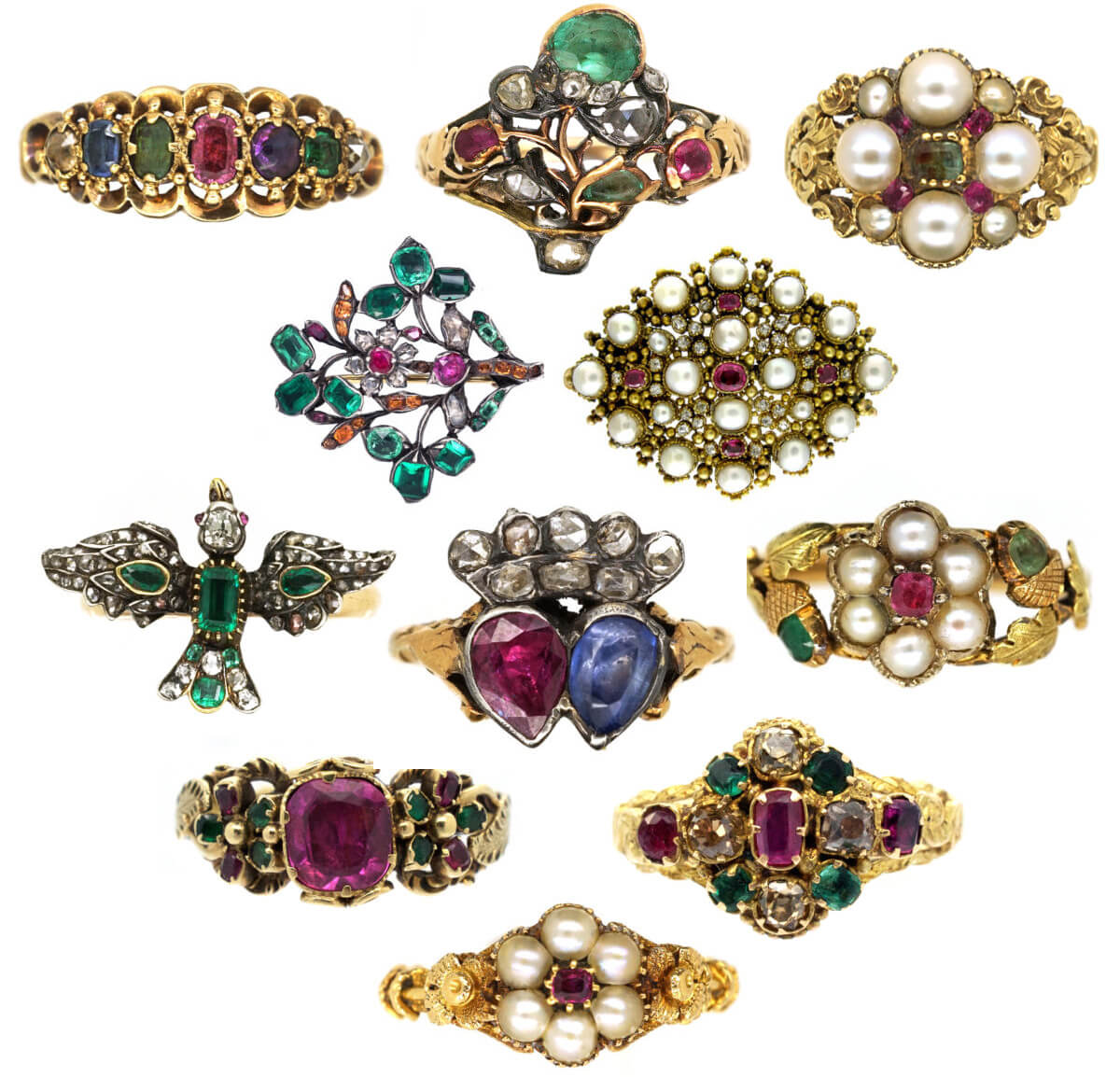
Georgian Era
The Georgian time period was one of the longest Eras in the history of Jewelry spanning over 100 years and four English Kings, King George I-George IV. During this 123 year reign, there was minimal advancement in style and technique of Jewelry. The metals commonly used in jewelry were high Karat gold and silver. The cutting of the Diamonds and Gemstones was primitive, using mainly Foil Backs, Old Mine cut, Table Cut, Rose Cut and Cabochon.
Common stones used were Diamond, Ruby, Sapphire, Quartz varieties, Garnet, Shell, Coral, Pearl, Agate and Glass. Stones would be considered poorly cut by todays standards, and often do not match as they were all different shapes and sizes. Construction and the way the stones were set were not the most durable, therefore authentic Georgian Jewelry can be hard to procure. Nature motifs of flowers, leaves and wreaths were popular. Feminine styles of ribbons and bows were commonly seen during the mid-late Georgian period.
1837-1901
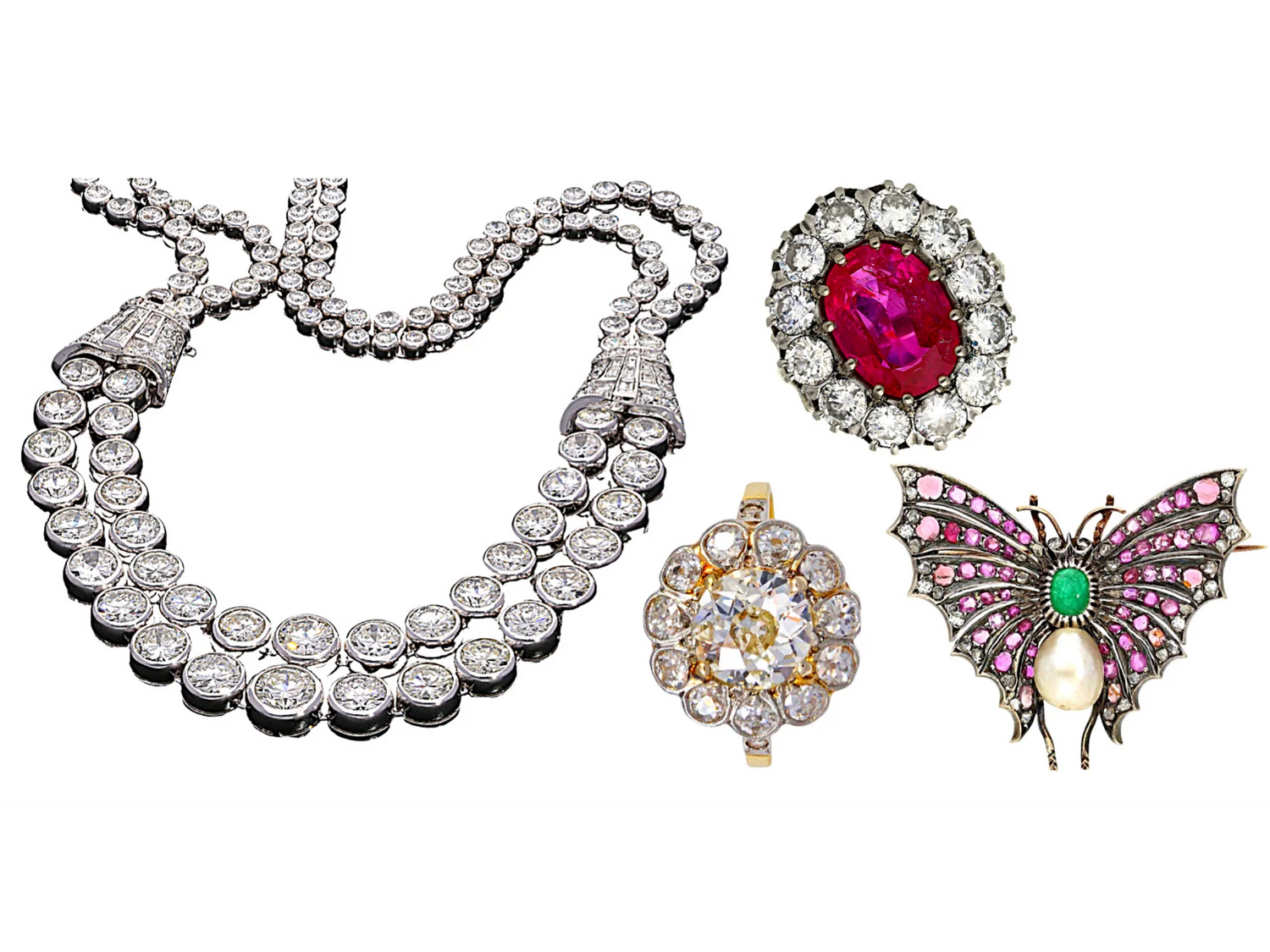
Victorian Era
The Victorian Era, was named after the beloved Queen Victoria. The Victorian Era can be broken down into three categories; Early Victorian, or “Romantic”, Middle Victorian, or “Grand, and late Victorian or “Aesthetic”. Common metals used during the Victorian time period were still gold, silver, and rolled gold filled. Popular stones used were Diamond, Garnet, Amethyst, Turquoise, Sapphire, Pearl, Agate, Amber and Quartz. Animal and snake motifs were also commonly seen. Stones were usually cut as rose cut, old mine cut, European cut or cabochon. Ladies were adorned with stud earrings, stick pins, lockets, bracelets and vinaigrettes.
The Romantic Era reflected religion and the love of the ruling couple- Victoria and Albert. Designs included hearts, hands, crosses and knots. Snake jewelry became very trendy during this time period as it was a sign of eternal love.
The Grand Era is when Mourning Jewelry was introduced. Lockets containing pictures or locks of hair of loved ones. Styles got bolder, and more intricate metal work was more commonly seen. The Grand period Jewelry introduced new stone setting techniques including gypsy and pave’ setting.
The Aesthetic Era jewelry became darker and dismal as Victoria was mourned the death of Albert in 1861. Stones tended to be dark in color, using Jet, onyx, tortoise, fossilized coal or wood were used to represent the lack of light and life.
Also in the Aesthetic Era fashion and jewelry lightened up from the large statement pieces of the Grand Era. Styles became more delicate. Popular motifs included animal heads, bows, barrels, crescents, good luck symbols, knots, leaves, starts, double hearts and crowns.
1901-1915
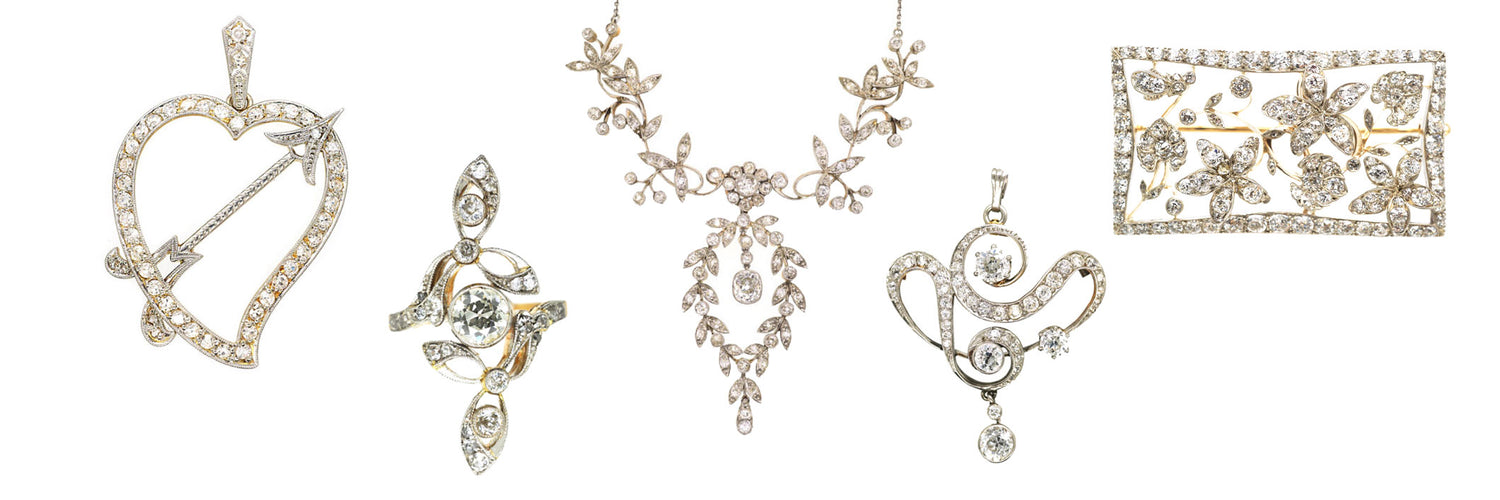
Edwardian Era
Edwardian Era spanned over the reign of King Edward. During this time period is when platinum first hit the jewelry scene and became the most common used material. Styles got more ornate and delicate with intricate floral designs and open filigree work. Advancement in symmetry and attention to detail were prominent. The art of milgraining platinum was introduced. Popular stones included Diamonds and Pearls.
1890-1910
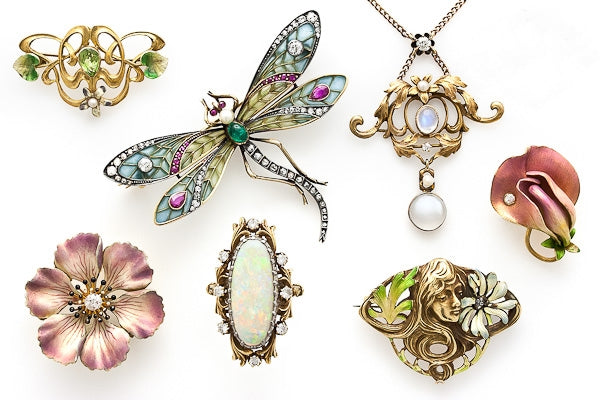
Art Nouveau Era
French for “New Art” after the 1895 opening of Siegfried Bing’s Parisian gallery, Maison de l’art Nouveau. Design became feminine, organic, flowery and draping. Although Art Nouveau Era overlaps with the Edwardian period, styles were very different. Art Nouveau was not as symmetrical, more freeform and softer curves. Plants, ladies portraits and flowers were favored.
1920-1945
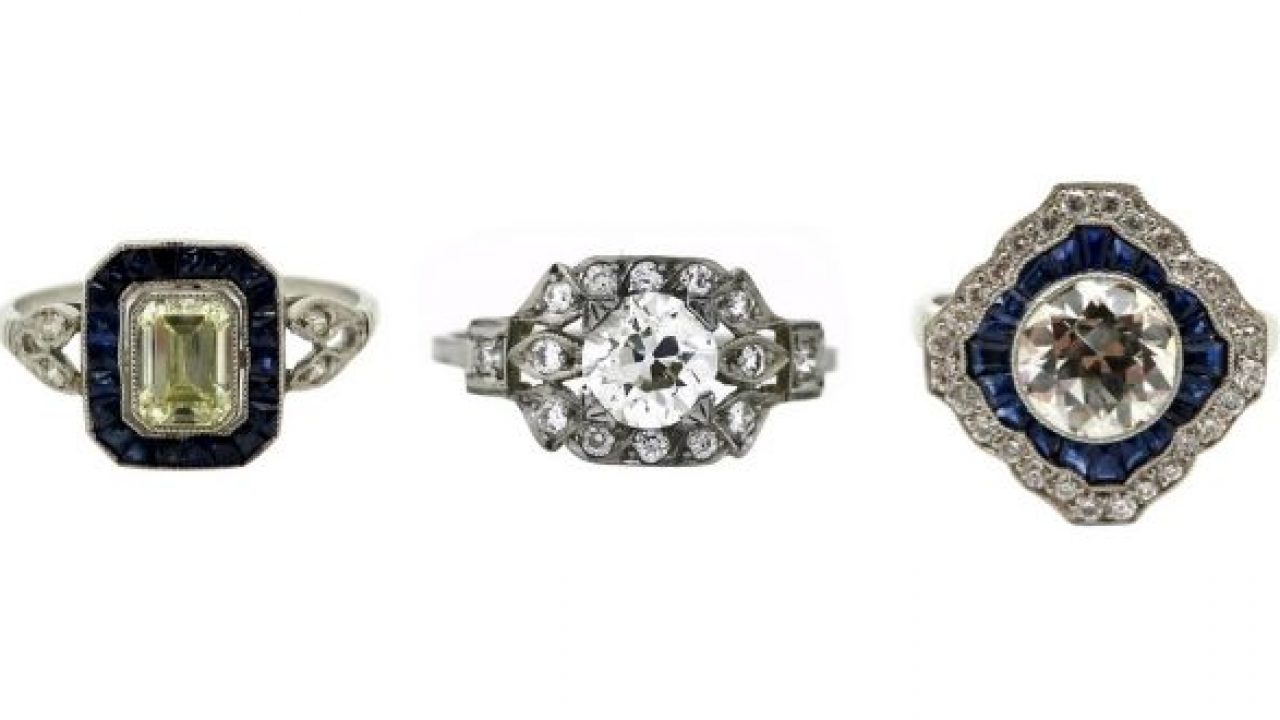
Art Deco Era
The Deco Era emerged after World War I. Styles were very geometrical and symmetrical. The introduction of white gold became popular, along with platinum. Inspiration was taken from industrial change. Sharp angles, triangular, blocks, squares, polygons and complex angular shapes took charge. High contrast colors, Black and White, Blue Sapphires next to cool colored white gold or platinum were trendy. The intricate filigree and milgrain stayed in demand, but in very symmetrical. White gold, Platinum and Sapphire were commonly used.
1935-1950
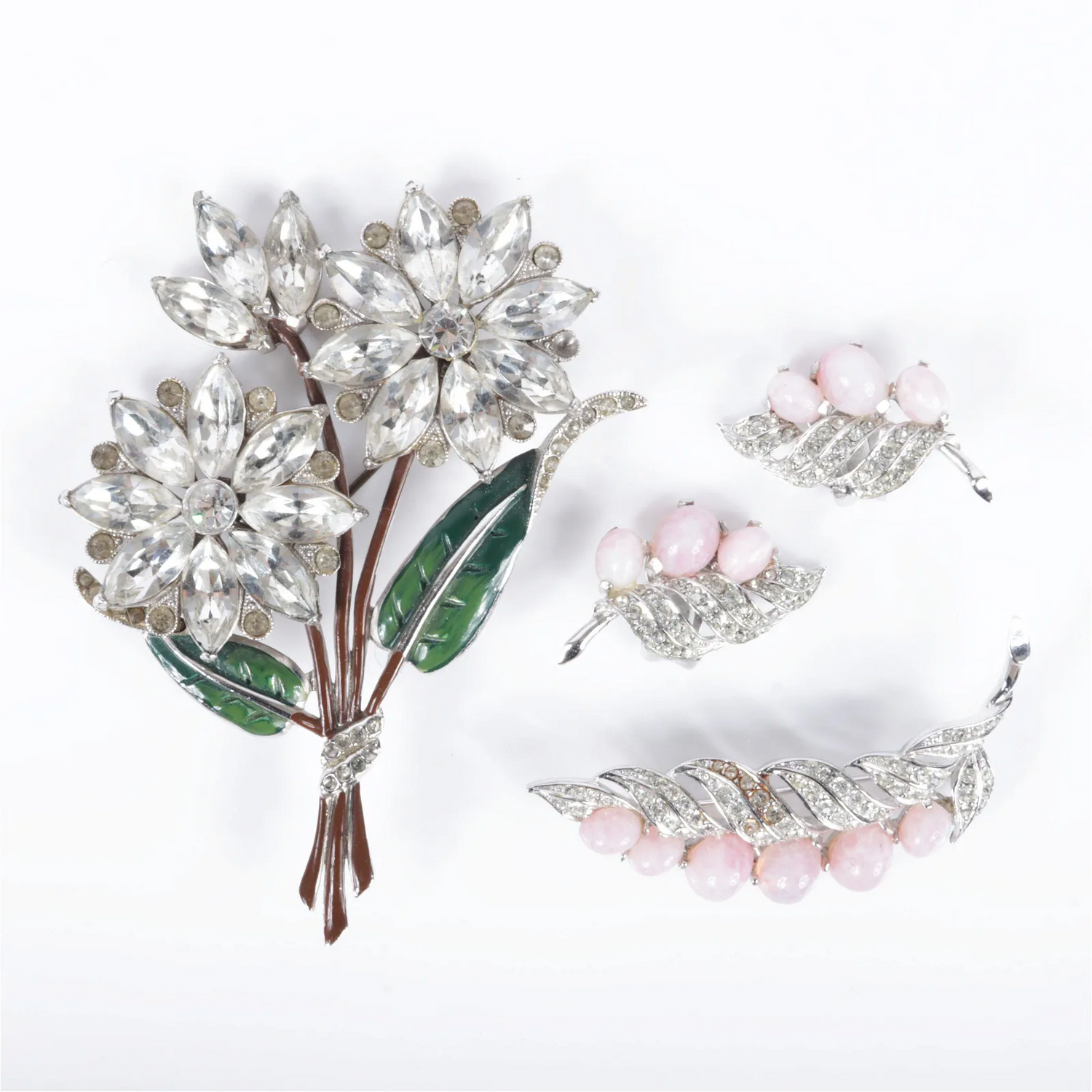
Retro Era
In the Retro era, the angles and blunt lines softened. Metal work incorporated more textures manipulated into weaves and twists. White metals were being rationed for the war, so yellow gold and low karat gold became the norm. Experimenting with gold alloys to create new tones. Rings without stones became more prevalent. If gemstone were used, lesser expensive quartz and Topaz varieties were common. Instead of buy new, people would redesign and repurpose existing pieces. In the later Retro period, bolder styles became popular. Fan, spray and ribbon styles in larger “cocktail” style rings because en vogue. Large earrings with clip backs adorned the ears.



